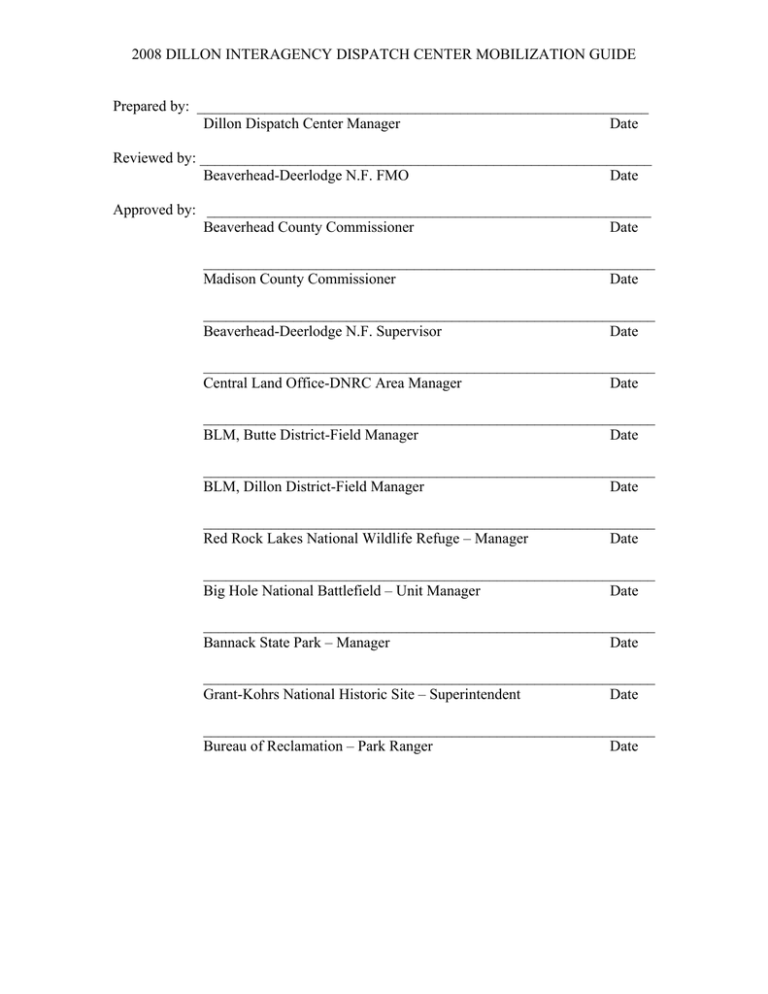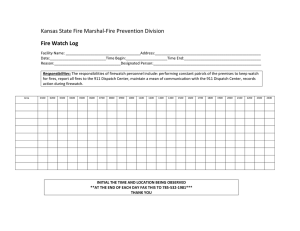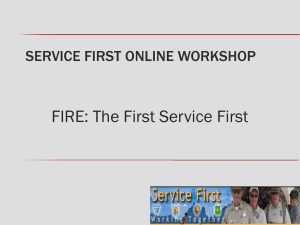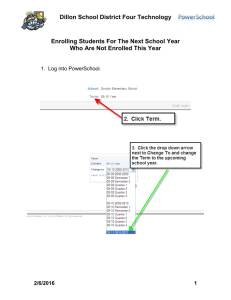2008 DILLON INTERAGENCY DISPATCH CENTER MOBILIZATION GUIDE Prepared by: ____________________________________________________________
advertisement

2008 DILLON INTERAGENCY DISPATCH CENTER MOBILIZATION GUIDE Prepared by: ____________________________________________________________ Dillon Dispatch Center Manager Date Reviewed by: ____________________________________________________________ Beaverhead-Deerlodge N.F. FMO Date Approved by: ___________________________________________________________ Beaverhead County Commissioner Date ____________________________________________________________ Madison County Commissioner Date ____________________________________________________________ Beaverhead-Deerlodge N.F. Supervisor Date ____________________________________________________________ Central Land Office-DNRC Area Manager Date ____________________________________________________________ BLM, Butte District-Field Manager Date ____________________________________________________________ BLM, Dillon District-Field Manager Date ____________________________________________________________ Red Rock Lakes National Wildlife Refuge – Manager Date ____________________________________________________________ Big Hole National Battlefield – Unit Manager Date ____________________________________________________________ Bannack State Park – Manager Date ____________________________________________________________ Grant-Kohrs National Historic Site – Superintendent Date ____________________________________________________________ Bureau of Reclamation – Park Ranger Date DILLON INTERAGENCY DISPATCH CENTER MOBILIZATION GUIDE CONTENTS Chapter 10 Objectives-Policy-Scope of Operation Chapter 20 Administrative Procedures Chapter 30 Organization Chapter 40 Cooperation Chapter 50 Directory Chapter 60 Personnel Chapter 70 Equipment and Supplies Chapter 80 Air Appendix A DDC’s Cooperators Communication Plan Appendix B B-D Preparedness Plan Appendix C DDC, State-County Coop Fire Procedures Appendix D Crew Roster and Assignment Appendix E Crew Equipment List 2 K:\rtf\fire\Mob_Guide\2008 Mobe Guide\Chapter 10.doc May 2008 DILLON INTERAGENCY DISPATCH CENTER MOBILIZATION GUIDE CHAPTER 10: OBJECTIVES, POLICY AND SCOPE OF OPERATION 11 General 12 Mission Total Mobility Priorities Definitions 13 Mobilization/Demobilization Policy Resource Order Forms Notification of Commitment of National Resources Fill or Kill Weather Reports Fire Behavior Fire Reports Wildland Fire Situation Analysis (WFSA) Procedures In Fire Protection Areas 14 Scope of Operation General Mutual Aid Agreements Search and Rescue 3 K:\rtf\fire\Mob_Guide\2008 Mobe Guide\Chapter 10.doc May 2008 DILLON INTERAGENCY DISPATCH CENTER MOBILIZATION GUIDE 11. General Objectives and Policies This mobilization guide will facilitate emergency responses to emerging Wildland fires and other incidents of an urgent nature. Policies and procedures of mobilization of resources from agencies that have direct protection responsibility of federal, state and county land will be outlined in this guide. DDC has the additional responsibility to notify agencies with administrative responsibility for involved land if it is not the same as the agency taking initial action. 12. Mission Statements To plan for and provide DDC cooperators with coordinated use of suppression forces during the occurrence of wildland fire incidents and to maximize efficiency and minimize suppression costs using the safest possible means. 12.1 Total Mobility Dispatching will be done using the closest forces concept through positioning and utilizing established resources to meet anticipated and existing fire protection need regardless of geographic location or agency affiliation. 12.2 Priorities A. Protection of human life and personal property is paramount in all fire and fuels management activities. B. In the event of shortages of personnel, equipment or supplies during multiple fire situations, the following priorities will be considered: 1. Firefighter and public safety is the first priority in every fire management activity. 2. High resource values 3. Other areas outside classified wilderness and primitive areas 4. Wilderness areas not covered by an approved fire management plan 5. Approved fire management areas 4 K:\rtf\fire\Mob_Guide\2008 Mobe Guide\Chapter 10.doc May 2008 DILLON INTERAGENCY DISPATCH CENTER MOBILIZATION GUIDE 12.3 Definition of Terms Agency – One of the participants that are a party to this plan; Forest Service, Park Service, Montana Department of Natural Resources and Conservation, Bureau of Land Management and counties. Agency Representative – A person assigned by the Agency Administrator to be responsible for making decisions concerning fire management activities for their organization at the Forest/Unit/Land Office level. Agency with Protection Responsibility – The agency with designated wildland fire protection responsibility for a defined area. Agency with Ownership/Jurisdiction – The agency that owns the land or acts on behalf of the owner. This may or may not be the agency with protection responsibilities. AP – Anaconda Pintler Wilderness Area CLO – Central Land Office, Department of Natural Resources and Conservation (Helena) County – A local administrative subdivision of the State. County Fire Advisor (CFA) – Advises the county on county and state responsibilities. Normally is requested by a county and works for the county IC. Advises the county on strategy and tactics, responsibilities of multiple jurisdiction fires, and keeps the DNRC line officer informed of the situation. Normally does not assume command of the fire. DDC Operations Area – The area within the protection boundaries of the Dillon Unit of the DNRC; the Beaverhead-Deerlodge National Forests; The BLM Butte and Dillon Field Offices; and Beaverhead, Madison, Butte-Silverbow, Powell, Granite, Deerlodge Counties and portions of Jefferson county. Dillon Interagency Dispatch Center (DDC) – An interagency dispatch center set up to perform fire and other emergency dispatching for the Beaverhead-Deerlodge National Forests, Bureau of Land Management and the Dillon Unit, Department of Natural Resources and Conservation. District – A USFS Ranger District, BLM Field Office or DNRC Unit who’s Agency Administrator has authority over agency programs with in the district/unit geographical boundary. 5 K:\rtf\fire\Mob_Guide\2008 Mobe Guide\Chapter 10.doc May 2008 DILLON INTERAGENCY DISPATCH CENTER MOBILIZATION GUIDE Duty Officer – A person assigned by the Agency Administrator to be responsible for decision making aspects of fire management activities for their organization at the district level. Also serves as a 24-hour contact for dispatch. Fire Management Plan – (FMP) The Beaverhead-Deerlodge National Forests plan for all fire activities. The plan addresses prevention, pre-suppression, suppression, prescribed fire, fuels management, equipment, cooperation, fire reports, and management. The plan is updated annually. Fire Complexity Analysis- Appendix C in the Management Plan, this form is intended to evaluate the need for an overhead team. Will be done at the beginning of a fire, and again as needed throughout the incident. Forest – United Sates Department of Agriculture lands administered by the Supervisor’s Office in Dillon for the Beaverhead-Deerlodge National Forests. Initial Attack Dispatching – Dispatching actions taken to assure a prompt initial fire suppression response to a wildfire. Includes setting priorities among fires when resources are scarce. Initial Attack Resources – Agency resources who are trained and equipped as first responders. Initial Attack Zone – The area of initial attack responsibility for a unit or district. Land Office – The administering body for one of six regions within the State of Montana. The Central Land Office, located in Helena is responsible for state lands within Beaverhead and Madison Counties. Liaison Officer - A person responsible for assisting and cooperation with agencies or the agency representatives. Mobilization Guide – Agency specific guidelines for wildfire preparedness and response. NRCC – Northern Rockies Coordination Center in Missoula. NICC – National Interagency Coordination Center in Boise. Overload – A situation where the work capacity of a dispatch center is exceeded. Peak Load- The maximum level at which a dispatch center is expected to operate based on historical fire occurrence records. 6 K:\rtf\fire\Mob_Guide\2008 Mobe Guide\Chapter 10.doc May 2008 DILLON INTERAGENCY DISPATCH CENTER MOBILIZATION GUIDE Resource Advisor – An employee of an agency who is qualified to advise an Incident Commander of acceptable suppression actions to be taken on agency owned lands. This position advises of threatened and endangered species, archeological sites, and sensitive areas, etc. Wildland Fire Situation Analysis – (WFSA) Appendix G in the Fire Management Action Plan, this form is used to document strategies and decisions whenever a fire exceeds initial action capabilities and is considered an escape. 13. Mobilization/Demobilization Policies The management of crew, overhead, equipment and support personnel to assure safe, productive fire suppression activity is a basic responsibility of fire management personnel. Use the guidelines in the Interagency Fire Business Management Handbook (NWCG Handbook 2) to assure adequate rest for fire suppression crews, overhead and support personnel. 13.1 Resource Orders Resource orders will be filled by qualified individuals, who have passed the physical fitness requirements for the job assignment. Assignments will be made by the dispatch center and will be approved in advance by the individual’s immediate supervisor, or as required by local policy. Individuals will be issued a fire qualification card after passing their physical fitness test and completing the required annual refresher training. Movement of resources between units and requests for shared or off-zone resources will be coordinated through the dispatch center. The dispatcher will initiate actions to fill in behind committed resources considering the total capabilities of the zone. 13.2 Notification of Commitment of National Resources DDC will notify NRCC and neighbors via DMS to address: commit within 15 minutes of dispatching the National Type II Helicopter to an incident. Notification will be followed by a phone call to NRCC. 13.3 Fill or Kill Procedures Confirmation that a resource order can or cannot be filled will be sent by the receiving dispatcher within 30 minutes of receipt. Under some circumstances this may be negotiated between receiving unit and sending unit. 13.4 Weather Reports FTS automated weather stations are in operation at Ennis, Whitehall, Wise River and Philipsburg. Records can now be kept year-round. Indices will be generated from approximately April 1 through October 31. RAWS stations within the zone include Red Rocks, Brenner, Antelope (Lima), Argenta (seasonal), French Creek and Galena Gulch. 7 K:\rtf\fire\Mob_Guide\2008 Mobe Guide\Chapter 10.doc May 2008 DILLON INTERAGENCY DISPATCH CENTER MOBILIZATION GUIDE The National Weather Service will distribute morning fire weather forecasts, afternoon updates, fire weather watches, and red flag warnings as specified in their annual operating plan. All dispatch/coordination centers and unit dispatchers will be responsible for distributing fire weather information to firefighters and incident management personnel at initial attack bases, staging areas, field locations, and committed to initial attack/extended attack incidents. Weather information is available on the internet http://www.wrh.noaa.gov/mso/fireweather/. 13.5 Fire Behavior During periods of high fire danger (NRCC Preparedness Levels 35), general fire behavior information will be distributed to firefighting personnel. If the Geographic Area Fire Behavior Service Center is not operational, local agency administrators will determine the need to distribute fire behavior information. A fire behavior analyst should be considered for all fires having serious potential such as fires in fast burning fuels, high values, high fire danger, steep terrain, critical wind conditions, other factors that complicate line locations, or combinations of the above. 13.6 Fire Reports Initial attack crewpersons will complete their respective agency’s initial action report. Fire location coordinates (latitude/longitude, in degrees, minutes and seconds) will be included in the fire reports. The form FS-5100-29, Individual Fire Report, will be submitted in Firestat within 5 days of the fire being declared out. Specific direction for completion of 5100-29 and supplemental information needed for large fires can be found in the Forest Service Handbook 5109.14 Individual Fire Report Handbook. A completed DNRC form F-1000 will be sent by the Dillon Unit to the CLO in the event of DNRC related fires. For fires involving another agency’s land under a protection agreement, a copy of the fire report will also be sent to the appropriate agency. For all BLM fires, DDC will complete a Dept. of Interior Fire Report (DI-1202) using instructions provided by the BLM. DDC will then input the data into the BLM Shared Access Computer Systems (SACC’S) and send a report to the BLM FMO in Butte. This will be done within 10 days after the fire is declared out. All BLM fires 10 acres or greater will have their perimeter mapped using GPS (Global Positioning System) as stated in Information Bulletin (IB) No. OF&A 98-0303. This will be the responsibility of the agency protecting the specific BLM lands. The GPS file 8 K:\rtf\fire\Mob_Guide\2008 Mobe Guide\Chapter 10.doc May 2008 DILLON INTERAGENCY DISPATCH CENTER MOBILIZATION GUIDE will be provided to the BLM Western Zone Fire Management Officer. Wildland Fire Use and Escaped Prescribed Fires required additional reports of the Forest Service and for the Bureau of Land Management. Direction for completion of these reports can be found in FSH 5109.14 and BLM 9200 Manual. 13.7 Wildland Fire Situation Analysis (WFSA) If a fire escapes the initial action (first burning period) or burns out of prescription in an approved fire management area, a Wildland Fire Situation Analysis will be prepared by the responsible Agency Administrator. For multi-jurisdictional incidents, the Wildland Fire Situation Analysis will be completed jointly by all cooperators having jurisdictional responsibility and the related fire protection Agency Administrators. When considering staffing for Type I, II, or III incidents, a Fire Complexity Analysis will be completed by the District or Unit manager. DDC will process all team orders. Type I and II orders will be forwarded to NRCC for assignment of teams in rotation to incidents. Type III will be ordered at local, neighborhood or NRCC level depending on available resources. The WFSA and complexity analysis will be revalidated and revised daily during the incident. All person-caused fires will be investigated to determine the cause and liability. Special use permits and sale contract requirements will be enforced. 13.8 Procedures in Fire Protection Areas The following guidelines should be used to determine when the agency with suppression responsibility on lands administered by another agency should notify the administering agency of fire activity: 1. Notification DDC will notify the agency with ownership of all fires on their jurisdiction. Notify the Forest FMO of any fires. All agencies using DDC as an initial attack dispatch center will advise DDC of the agency duty officer or provide a call list of persons to notify. DDC will notify the agency with ownership of A and B fires after the first on scene reports are received. For fires that have the potential of being class C or larger the agency with ownership will be notified as soon as possible. The agency with ownership will determine the need for a Resource Advisor. 9 K:\rtf\fire\Mob_Guide\2008 Mobe Guide\Chapter 10.doc May 2008 DILLON INTERAGENCY DISPATCH CENTER MOBILIZATION GUIDE 2. Suppression strategies All lands under special management (i.e. road restrictions, wilderness study areas, cultural resources, T & E species, etc.) will require the agency with ownership and agency with suppression responsibility to contribute to the process of: a. Determining overall incident objectives. b. Selection of strategies. c. Ensuring the joint planning of tactical activities will be accomplished. d. Ensuring that integrated tactical operations are conducted. e. Making maximum use of all assigned resources. f. Providing Resource Advisor if needed. 3. Fire investigation If the initial attack IC suspects that a fire is person-caused, she/he will notify DDC or the District/Unit duty officer. All person-caused fires will be investigated to determine specific cause and possibility of reimbursement. If a fire investigator is needed, a resource order will be placed with DDC. The order will be filled by the closest available, qualified investigator. For fires on Bureau of Land Management (BLM) land, the Bureau manual ref H-9238-1 Fire Trespass will be taken into consideration. The policy states that costs will be tracked for cost recovery of all human-caused fires on public BLM lands. If cost recovery is not applicable to a certain fire, documentation must be provided to the Bureau. The pursuing of cost recovery will also apply to other agency lands under the protection agreement where the BLM is not reimbursed for suppression actions. In accordance to the Fire Trespass policy, all human-caused fires will have procedures taken to recuperate the cost of suppression activities when a suspect has been identified. Recovery for cost will also apply to land rehabilitation, for damages to the resources and improvements. Fires started by natural causes will not require trespass and cost recovery efforts. 4. Operations Fire (contractor) In the case of a suspected contractor-caused fire, DDC will notify the District/Unit/Field Office Duty Officer or FMO, who will notify the contracting officer, COR, timber sale officer, or engineering representatives in charge of the operation. Operations fires will be investigated. 10 K:\rtf\fire\Mob_Guide\2008 Mobe Guide\Chapter 10.doc May 2008 DILLON INTERAGENCY DISPATCH CENTER MOBILIZATION GUIDE 14 Scope of Operation 14.1 General The Dillon Interagency Dispatch Center Mobilization Guide contains dispatching procedures and organization. Included is a directory of personnel, equipment, aircraft and supplies to assist in obtaining prompt and adequate dispatching to insure the appropriate management response to all fires. 14.2 Mutual Aid Agreements A. DDC/County Co-op fires When a 911 County Dispatch office and/or a County Fire warden requests state assistance through the State/County Co-op Agreement, consider adjacent county mutual aid resources prior to involving federal or state resources. Response time should be considered. Contact the designated DNRC County Fire Advisor. After initial dispatch by the 911 County Dispatches of rural volunteer fire departments (RVFDs) to wildland fire incidents, support dispatch communications will be through DDC. Upon establishing the communications links, check-in schedules will be established by the IC and DDC. Upon initiation of demobilization procedures, the I.C. will notify DDC of the actions taken. B. Flow chart and procedures for the county to request assistance on wildland fires beyond the county’s capabilities: see Appendix A C. General comments on the use of County/RVFD resources: 1. Local resources need only meet their own equipment/safety standards as determined by the local Fire Chief when they are responding within their jurisdiction. When responding on Federal or State land resources must meet NWCG standards. 2. Local resources are not paid to suppress fires in their own jurisdiction. 3. When using local resources, don’t assume that you have control; use the appropriate chain of command. 4. Make sure you understand the responsibilities, capabilities, training and experience of the county/RVFD resources before incorporating them into the suppression plan. 5. When paying county/RVFD resources, they are hired as State employees (EFF’s) and not AD’s. 11 K:\rtf\fire\Mob_Guide\2008 Mobe Guide\Chapter 10.doc May 2008 DILLON INTERAGENCY DISPATCH CENTER MOBILIZATION GUIDE 14.3 Search and Rescue The county sheriff’s office is the coordinating office for search and rescue missions. Dispatch will coordinate any participation with the sheriff’s office and will operate in accordance with the applicable agency’s emergency policy and procedures. 12 K:\rtf\fire\Mob_Guide\2008 Mobe Guide\Chapter 10.doc May 2008



